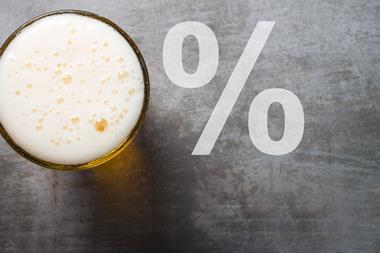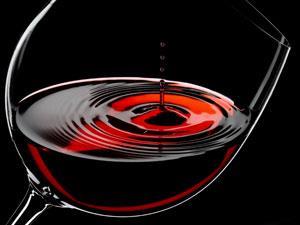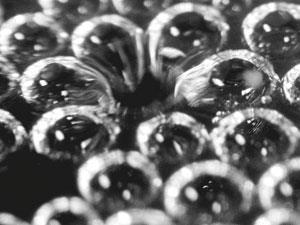Chemicals are responsible for the flavour and bouquet of wine. Could understanding the chemistry help you pick the ideal tipple for your Christmas dinner? Katie Gibb investigates
Few people will consider chemistry's role in producing a good vintage when they select the perfect wine to accompany Christmas dinner. But many winemakers are turning to science to ensure the perfect bottle.
Wine is a complex blend of compounds. Water and ethanol are the key components, with acids, sugars, phenols, carbon dioxide, aromatics, salts, sulfur dioxide and other substances in much smaller quantities. The relative contributions of each are very much dependent on factors such as the climate in which the grapes are grown and the type of soil in the vineyard: referred to by the French as the terroir.
But chemists believe there are other factors that determine whether a wine sells itself or stays on the shelf. Companies, such as Excell Laboratory in France, work with the wine industry on quality control, examining the materials in direct contact with wine and analysing trace contaminants.
The human perception of what flavours make a wine pleasurable to drink is also important, as Leigh Francis, senior research chemist at the Australian Wine Research Institute explains: 'A consumer tasting a red wine will receive a totality of impressions of the components in the wine, and this overall perception of aroma, taste and mouthfeel from the numerous chemical compounds in a wine will give rise to the more or less attractive nature of the wine.'
Alcohol forms the very heart of wine, contributing to the flavour and helping to increase the viscosity. It is mostly in the form of ethyl alcohol which is produced from the sugar in the grape juice by yeast during the fermentation process. A small amount of methyl alcohol is also present, originating from the seeds.
Acids and sugars combine to produce the main flavour of wine. They also activate saliva production. Acids such as tartaric and acetic acid are present in varying amounts, typically ranging from around two grams per litre to seven grams per litre. They come from from the grapes themselves and as a product of the fermentation process.
Alcohols, sugars and acids
Grapes naturally contain high levels of sugar, most of which is converted into alcohol during fermentation, but some residual (non-fermented) sugars remain in the wine. The sugar content varies greatly from one wine to the next, typically with fewer than two grams per litre for dry wines, up to a few hundred grams per litre for sweet wines. Sugar and alcohol together create the richness of the wine and a mellow creaminess which is often referred to as moelleux.
Salty substances such as chlorides, potassium and sulfates are also present in wine in varying quantities, but these are usually undetectable in the flavour because the alcohols, sugars and acids dominate. 'The balance of the different compounds is most important. Winemakers understand the concept very well and will seek the right acid/sugar balance in white wines,' says Francis.
Phenolic compounds also contribute to the flavour of wine. They fall into two broad categories: pigments and tannins. Both yellow pigments (flavanols) and red pigments (anthocyanins) contribute to the colour of the wine. Tannins, on the other hand, are organic compounds that are present in grape skins and seeds, and they contribute considerably to the flavour, producing the characteristic astringency found in full-bodied red wines. When red wine is produced, the grapes are crushed and the juice is left to sit on the skins for long periods, often for 30 days or more, allowing the tannins to seep into the juice. With white wine, the juice is left to sit on the skins for only a matter of hours, giving much lower concentrations of tannins. During the ageing process for red wines, the tannins combine with the anthocyanins to stabilise the colour and decrease the astringency. Tannin levels need to be controlled carefully because an excess can tip the balance from astringency to unpleasant bitterness.
What's in a smell?
Wine gains the richness and complexity of its aroma or bouquet from aromatic compounds that are produced during fermentation. 'A recent study on white wines found that wine aroma.could be predicted quite well from measurement of a fairly small number of key volatile compounds,' Francis explains. Typical examples include alcohols, fatty acids, aldehydes and esters. For instance, phenylethanol commonly gives an aroma of roses, piperidine an aroma of black pepper, and diacetyl an aroma of butter.
Wine aroma can be predicted by measuring a small number of volatile compounds
Carbon dioxide, which is produced in varying levels by the fermentation process, helps release the wine's aroma. It also helps accentuate the wine's acidity and gives it extra freshness. At low quantities it is hardly detectable, but at around 1000 milligrams per litre bubbles are produced, creating a sparkling wine. These can be created by bottling an already fermented wine with additional yeast, sealing it to prevent the carbon dioxide from escaping, and allowing fermentation to start again. Later, the bottle is opened and the yeast sediment is removed.
With so many factors contributing to a wine's flavour and bouquet, there is often a danger that the delicate balance will shift during ageing and storage. Many winemakers therefore add sulfur dioxide, which acts as an antimicrobial agent and as an antioxidant, to preserve the quality of a wine.
However, even the best wineries in the world can still suffer from corked wines. This spoilage of the wine, with a distinct mushroom aroma and damp cardboard taste, makes a wine undrinkable. It has been estimated to affect between two and five per cent of wines, and has long been attributed to contamination of the natural cork stopper with the compound 2,4,6-trichloroanisole (TCA).
TCA is produced from trichlorophenol by a microorganism that thrives during the cork making process. Once contaminated with TCA, only a very small amount in the cork is needed to spoil the wine. Pascal Chatonnet, director of Excell Laboratory, explains that although TCA is often blamed, similar compounds, such as TeCA (2,3,4,6-tetrachloroanisole) and 2,4,6-tribromoanisole, can also cause the same corked effect. 'These two molecules have more or less the same odour as the TCA,' he says. The compounds themselves have a very strong flavour, and only trace concentrations (less than five nanograms per litre) can pollute the flavour of the wine.
Although the cork is often the culprit, Chatonnet says that TCA contamination can also come from a variety of other sources, such as storage barrels, wooden pallets or shipment containers.
It is possible to treat a wine after it has been spoiled with a TCA-related compound, as long as it has not been bottled, by selecting materials with very strong chemical or physical affinity for the contaminant. These can be used to reduce or eliminate the contaminants, allowing the off-flavour of the spoiled wine to be reduced.
Plastic corks can be used to minimise the risk of producing corked wine. But these have other drawbacks. The seal produced by plastic stoppers is not as efficient as with natural cork. Consequently, they allow greater transmission of oxygen into the bottle. Wines are very sensitive to oxygen, with the fruity aromas that result from sulfur-containing compounds quickly disappearing on oxidation. Consequently, more sulfur dioxide is often added to wines sealed with synthetic corks to prevent this from occurring so readily. Plastic stoppers are therefore used mostly for cheaper wines that are meant to be consumed within two years of production.
The other commonly used alternative is the metal screw cap. This forms an extremely efficient seal, allowing even less transfer of oxygen than natural cork. However, for some wines, such as full-bodied reds, this can be a problem because it encourages reduction, producing volatile sulfur compounds. Not all winemakers see this as a disadvantage, however, because in moderation it can be used to modify slightly characteristics such as flavour and aroma.
Chatonnet favours natural cork and screw caps. 'I think that the solution to this problem today [corked wine] is with the use of top quality natural corks or screw caps,' he says. 'For the plastic corks, we need to work on the development of a new generation of materials to be able to master properly the problem of oxidation damage.'
Food for wine
But, corked wine and oxidation damage aside, how important is the balance of chemicals in a wine to what we eat with them? Is the chemical interaction that happens between the food components and wine chemicals important? Chatonnet doesn't believe so. 'I think that the complementarity between food and wine is more psychology than chemistry. I haven't yet seen an illustration of the chemical interaction between food components and wine components. I think that it is more a question of the complementarities of the food or the wine.'
But some think there may be more to it than that, as Francis explains. 'There are numerous aromatic compounds in wine contributing to flavour, and they will interact to suppress or mask each other, as well as give rise to specific aroma notes, depending on the balance of the compounds in a particular wine. This also happens with taste compounds, where for example the suppression of the perception of the sour taste of acids by sweet compounds, whether sugars or an alcohol such as glycerol, is very important in how harsh or 'soft' a wine will taste.' Francis believes that there is still little understanding of how the aroma and non-volatile compounds such as tannins influence each other; 'it's a complex area to carry out research in but it is very important,' he says.
So is there a reason why we stereotypically prefer to consume red wine with cheese, and white wine with fish? 'I'm sure the degree of acidity and level of drying tannin, as well as sweetness and level of alcohol in a wine, will all affect how certain flavours of foods are perceived. For example, salty foods will reduce the perception of acidity in a wine, due to well known taste suppression effects, and it is likely that protein in foods such as cheese will affect astringency of red wines by precipitating tannins, reducing their perceived intensity,' adds Francis.
Salty foods reduce the perception of acidity in wine
And what about the effect created by adding cinnamon and a few cloves to red wine to produce mulled wine? The difference to the flavour and aroma of the wine is dramatic, but what happens when we create this long-favoured winter drink? Chatonnet believes he knows the answer.
Wines are usually aged in wooden barrels, which are often charred before their first use to give a more distinctive flavour to the wine. This process converts a compound found in oak known as lignin into vanillin, a phenolic aldehyde with a typical vanilla aroma, and eugenol, a volatile phenol. 'Eugenol, normally present in very small quantities in wine, is increased in quantity when you age wine in barrels,' explains Chatonnet. The leaching of these into the ageing wine produces a characteristic toasted flavour.
He thinks that the addition of cloves and cinnamon to wine during the mulling process has a very similar effect. 'Cinnamon is very rich in cinnamic aldehyde, which is also a phenolic aldehyde,' he says. Like the vanillin, the cinnamic aldehyde has a typical aroma, although this time it is of cinnamon. Cloves are very rich in eugenol, so when combined with the phenolic aldehyde a toasty flavour is achieved similar to that of ageing.
Choosing a wine
So bearing all this is mind, what would be the perfect wine to drink with a traditional Christmas dinner of roast turkey and Christmas pudding? Xavier Rousset, chef sommelier at Le Manoir aux Quat' Saisons, a two-Michelin star restaurant, has some suggestions. 'For the turkey, either a Grenache-Shiraz-Mourvedre from Australia, which is a powerful and very much winter wine but also very juicy, or the equivalent in France could be Chateauneuf du Pape or Gigondas,' he says. 'Regarding Christmas pudding, one of my all time favourites is Tokaji 5 puttonyos, 6 puttonyos being too rich. Dried apricot, cinnamon, and the acidity level make it so much lighter, a great combination,' he adds.
At prices of around £15-20 per bottle these may not make it onto everyone's table this Christmas, but until science can unravel the complexities of taste, most will continue either to follow the experts' advice or simply drink what they enjoy.
Wine and health
The French have among the lowest incidence of heart disease, despite their gastronomic culture. This 'French paradox' has long been attributed to the fact that red wine is the social drink of the nation, and it has been suggested that drinking a glass of red wine each day can have great benefits for the heart. But how much truth is there in this?
'Epidemiologic studies indicate that people who drink one to two glasses of wine per day have lower (compared with non-drinkers and heavy drinkers) incidences of some degenerative diseases including cardiovascular disease and cancer,' says Susan Ebeler, associate professor at the department of viticulture and enology at the University of California Davis, US. 'Some animal studies have also shown these beneficial effects.'
The compounds thought to be important for the health protective effects are polyphenols; antioxidants that are present in much larger quantities in red wines.
One particular polyphenol that has gained a lot of press in recent years is resveratrol, which has been shown to reduce the incidence of tumours in animals and inhibit the growth of cancer cells in cultures. New research also suggests that resveratrol may reduce levels of a compound linked to Alzheimer's disease.
Although still under study in humans, resveratrol is thought to help prevent cancer in animals by interfering with cancer cell development. More recently it has also been shown to decrease cell production of inflammatory molecules responsible for lung disease and exhibit blood-thinning properties, potentially protecting the arteries from clogging. It is, however, usually present only at very low concentrations in wine.
'Other compounds, present at higher concentrations have been shown to have similar activities. However, the exact compounds responsible for the health protective effects of polyphenols and their mechanisms of action in vivo are not known,' admits Ebeler.
'Our research is currently looking at how polyphenols interact with DNA to affect tumour development. We previously showed that polyphenol compounds from wine can inhibit tumour development in an animal model. The aim of our current work is to begin to understand mechanisms by which polyphenols can inhibit tumour growth and development.'









No comments yet